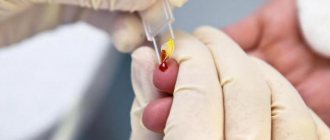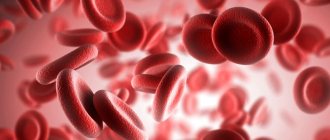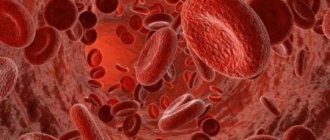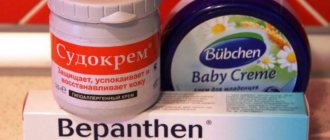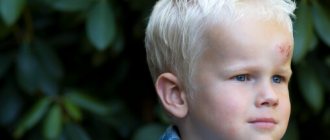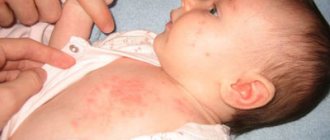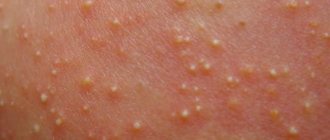Why does a child's nose bleed?
In the nasal region there is a network of vessels and small capillaries, which, when ruptured, provoke bleeding. Dry and irritated vessels become very brittle and can bleed from any, even minor, damage.
The most common causes of nosebleeds in a child or newborn:
Dry mucous membrane. It is provoked by the harmful effects of heating devices, sudden changes in temperature, abuse of vasoconstrictor drops during a runny nose; Increased intracranial pressure; Infection (eg, sinusitis); Nose injury (often caused by nose picking or bruise); Entry of a foreign body (for example, toy parts) into the nose; Incorrect shape of the nose from birth (deviated nasal septum); Proliferation of polyps in the nose.
Should I be concerned when I see blood coming from my baby's nose?
As a rule, the concern is unfounded.
In winter, when heating appliances operate at full capacity and the spread of infections reaches critical levels, nosebleeds are not uncommon. According to doctors, this problem can bother infants, but it completely disappears by adolescence. The thing is that the newborn’s blood vessels are still too weak and cannot withstand irritants.
How to prevent nosebleeds in infants?
If the air in the apartment is too dry, you should purchase a humidifier for the child’s room. It will help create a comfortable microclimate and maintain the desired level of humidity.
Make sure that the child does not put anything into the nose, including his own fingers.
If bleeding due to a dry nose recurs regularly, you should talk to your doctor about using saline nasal instillation. It moisturizes the mucous membrane and strengthens blood vessels.
In what cases does nosebleeds in a child require consulting a doctor:
Bleeding occurs as a result of a fall, injury to the head or nose, or a blow; The baby has leaked too much blood and you suspect danger; The bleeding started after taking some medications; The baby has constant nasal congestion and bleeds more often than before. If, in addition to nosebleeds, the child easily bruises, the gums bleed.
Prevention measures
No preventive measures will protect a child from nasal injuries. In childhood they are inevitable. But if you explain basic personal safety measures to a grown-up child, then there is a high probability that you will still be able to do without serious injuries. And children under 2-3 years old simply cannot be left unattended for a long time.
Other preventive measures will help reduce the risk of nosebleeds:
strengthening the immune system, hardening procedures - will allow you to suffer from respiratory diseases less often; mandatory treatment of a runny nose - will prevent the development of chronic diseases of the nose and sinuses; maintaining cleanliness and temperature conditions in the child’s room will eliminate the negative influence of external factors as much as possible; Regular preventive medical examinations will allow you to diagnose serious diseases of internal organs at an early stage; a varied, nutritious and high-quality diet rich in vitamins and microelements will prevent vitamin deficiency and capillary fragility; Proper and regular cleansing of the nasal passages will not injure the mucous membranes and will eliminate mucus stagnation.
As you can see, everything is important in caring for a baby: routine, nutrition, living conditions, appropriate care. But the most important thing is to trust pediatricians and do not self-medicate. Very often, the wrong actions of parents lead to the fact that such a small problem as a nosebleed becomes a big problem that requires long-term treatment.
How to stop bleeding?
Calm the child and make him spit out blood. It should not get into the throat and cause nausea. Place the child on your lap so that his head is tilted slightly down. Press the napkin to the spout and secure it with your hand. You need to wait about 10 minutes without removing the napkin. If the child is quite old, you need to ask him to breathe through his mouth. In order for him not to be scared or bored, you can read a book or turn on a cartoon. After 10 minutes, check to see if the bleeding has stopped. If not, you need to put a cold compress on the bridge of your nose and cover your nose with a napkin again for 10 minutes. If the bleeding does not stop, you should definitely consult a doctor.
What not to do!
Do not allow the child to take a horizontal position or tilt his head back. This will cause blood to leak into the throat. Do not plug your nostrils with cotton swabs. They can stop the bleeding, but during removal they will again damage the mucous membrane and the problem will recur.
Hospital control methods
If the child’s bleeding cannot be stopped at home, he must be taken to the hospital, where the doctor will determine the cause of the pathology. This is done like this: the oral cavity is examined with a special flashlight and the source of bleeding is identified. After this, the damaged area is tamponed with a special hemostatic liquid, which should stop the flow of blood almost instantly. If this also does not help, a bandage is applied. Such a need arises very rarely.
In addition to all these procedures, the doctor looks to see if the nose or head is damaged, and whether bleeding is a sign of some other disease.
Children often tolerate nosebleeds very easily and are not even particularly frightened. However, the adult's task is to make every effort to prevent blood loss. Nosebleeds should not be allowed to become a habit in a child and be perceived as normal.
About the authorBecome an author
How did I become a doctor? Quite a difficult question... If you think about it, there was no choice. I was born into the family of a resuscitation doctor, and every day at dinner I heard my father’s story about how his day went. As a child, this all seemed fantastic, beyond reality.
More details
Nosebleeds are a common problem in childhood and adolescence. This is due to both the physiological characteristics of the structure of the nasal passages and the functioning of the immune system in children.
Parents' opinions about nosebleeds differ: some do not see the danger in this phenomenon and do not attach much importance to the problem, while others, on the contrary, begin to worry and worry, even if there is no apparent reason for this.
In any case, recurrent bleeding should not be ignored - they may be the first signal of possible health problems.
Algorithm of actions
Rules for providing first (emergency) aid for nosebleeds in a child:
- Calm the child and persuade him to spit out the blood.
If the child is too small and does not know how to spit, gently tilt his head down and try to unclench his jaws with your hands. In cases where the baby resists too actively, the action should be stopped.
- Apply a clean, thick cloth to your nose and press it for 8-10 minutes.
If there is no napkin, or the bleeding is quite intense, you can take a towel.
- Apply a cold compress to the bridge of the nose.
You can use frozen vegetables from the freezer, after wrapping them in a towel or thin diaper.
- If after 10-15 minutes the bleeding does not stop, call an ambulance.
In the video, Dr. Komarovsky describes to parents the main mistakes they make when trying to stop bleeding.
How to stop bleeding in a baby?
The technology for stopping bleeding in infants is not much different from the rules applied to older children and adolescents.
- First you need to calm the baby down.
If your baby gets very scared, this can cause high blood pressure and increased bleeding. The baby should not be allowed to cry. Infants do not know how to spit out blood that has accumulated in the mouth, so during an attack of severe crying, there is a possibility of blood clots getting into the throat and respiratory tract.
- If the baby already knows how to sit, he should be placed on your lap and his head tilted slightly forward.
If a newborn or one-year-old baby is bleeding, you should pick him up with his back up, but at the same time you need to support his head with one hand so that it is constantly raised.
- Then proceed according to the algorithm: apply a napkin or cloth and apply cold to the bridge of the nose.
What can't you do?
It is forbidden to tilt the child's head back, as he may choke on blood. For the same reason, you should not use cotton swabs (place them in the nostril) on infants, as they cannot breathe through their mouths, and blood can enter the respiratory tract.
By the way, it is not recommended for teenagers to plug their nostrils with tampons, since during removal they can again injure the mucous membrane, which will lead to re-bleeding.
Runny nose and other causes of nosebleeds in one-year-old children and adolescents
Nosebleeds are the result of damage to the capillaries, of which there are a huge number in the nasal cavity. Young children can simply “pick” the surface of the mucous membrane, which leads to blood flow.
But the reasons for this phenomenon may not always be harmless. Sometimes frequent nosebleeds indicate a serious pathology, so this symptom (especially if the baby is too small) cannot be ignored.
Low air humidity.
Dry air contains a lot of dust and harmful elements, which, when inhaled, settle on the mucous membranes and form growths (crusts). In addition, low air humidity negatively affects the condition of the mucous membrane, leading to its depletion. This process is called atrophy of the mucous membranes. If a child, picking his nose, picks off a dried growth, a wound will form and capillary bleeding will occur.
Arterial hypertension.
Blood pressure problems can also cause nosebleeds. In this case, bleeding only benefits the child, since it prevents more serious consequences, for example, hemorrhage in the brain. Bleeding is usually preceded by headache, weakness, and poor health. After the bleeding stops, the child feels much better.
Diseases of the hematopoietic system.
Disturbances in blood clotting processes (coagulopathy) are another serious cause of nosebleeds. In this case, the gums and other areas with mucous membranes will also bleed.
Vitamin deficiency.
A poor and monotonous diet low in beneficial elements (minerals and vitamins) can lead to various abnormalities and diseases. A lack of vitamin C negatively affects the condition of blood vessels - they become brittle and their walls are depleted, which increases the likelihood of damage.
Overheat.
Children especially often get sunstroke and heatstroke during walks in the summer. To avoid them, it is necessary to follow the rules for children's exposure to the sun in the summer. Walking during the high solstice (from 12 to 17 hours) for children under 6 years of age is strictly prohibited.
Infectious and respiratory diseases.
Colds, as well as diseases caused mainly by viruses, lead to the formation of swelling of the nasal mucosa and increased pressure in the capillaries, which cannot withstand the increased load and burst.
Inflammatory pathologies.
Inflammation of the nasal sinuses (sinusitis, sinusitis, frontal sinusitis), as well as adenoids, contribute to the filling of the mucous membranes with blood.
Fluctuations in barometric pressure.
During an air flight or traveling in the mountains, a child may develop a nosebleed. The reason will be increased rarefaction of air in conditions unusual for the child.
Pathologies of the heart and blood vessels.
Pressure surges in the vessels located in the neck and head area lead to fragility of the vascular walls and the onset of bleeding.
Anatomical features of the structure.
Some children have very narrow nasal passages, so any impact in the nasal cavity leads to injury to the mucous membrane and bleeding.
Taking medications.
Some parents are too zealous in treating a runny nose and use vasoconstrictor drugs designed to eliminate swelling and restore normal breathing.
Such medications cannot be used for more than 3 days, as they not only lose their effectiveness (addiction sets in), but also dry out the mucous membrane, making it thin and susceptible to mechanical stress.
Injuries and bruises.
If a child has a nosebleed, the cause may be a bruise. When children fall, they often hit their head and face, so you should carefully examine the surface and cavity of the nose for lacerations. If any are found, you should take the baby to a children's hospital.
Why does a baby's nose bleed?
In newborns and infants, frequent nosebleeds are usually a consequence of anatomical features.
The nasal passages are still too narrow, and the capillaries are weak, so they often burst with any overexertion or exposure to an irritating factor. For example, when crying for a long time and loudly, the baby may bleed from the nose.
If the house is hot and the air humidity does not meet the required standards, nosebleeds can also recur with enviable frequency.
Going to the hospital if you have frequent bleeding
Despite the fact that nosebleeds are most often not a sign of pathology, in some cases you will still have to show the baby to the doctor.
The baby needs urgent medical attention when:
- blood comes from both nostrils;
- it is not possible to stop the bleeding on your own (within 15 minutes);
- blood comes from the nose and from other organs (for example, bleeding from the vaginal tract is simultaneously observed);
- bleeding began after taking any drug (may indicate the onset of an anaphylactic reaction);
- blood flows like a fountain.
Important! The listed conditions are a reason for emergency hospitalization of the child and a thorough examination.
If blood flows from the nose regularly (more than once every 10-14 days), you should get tested, find out why the bleeding is bothering you and get advice from specialists. You can start by visiting a pediatrician or otolaryngologist, who, after reviewing the results of laboratory tests, will prescribe additional tests and examination by specialized specialists, for example:
- cardiologist;
- pediatric oncologist;
- hematologist.
